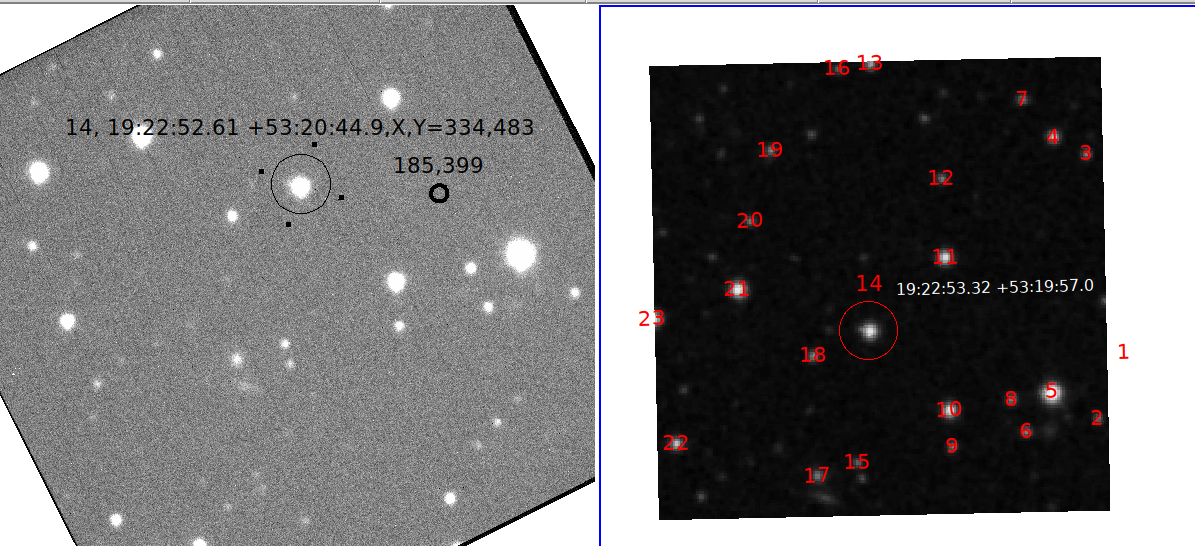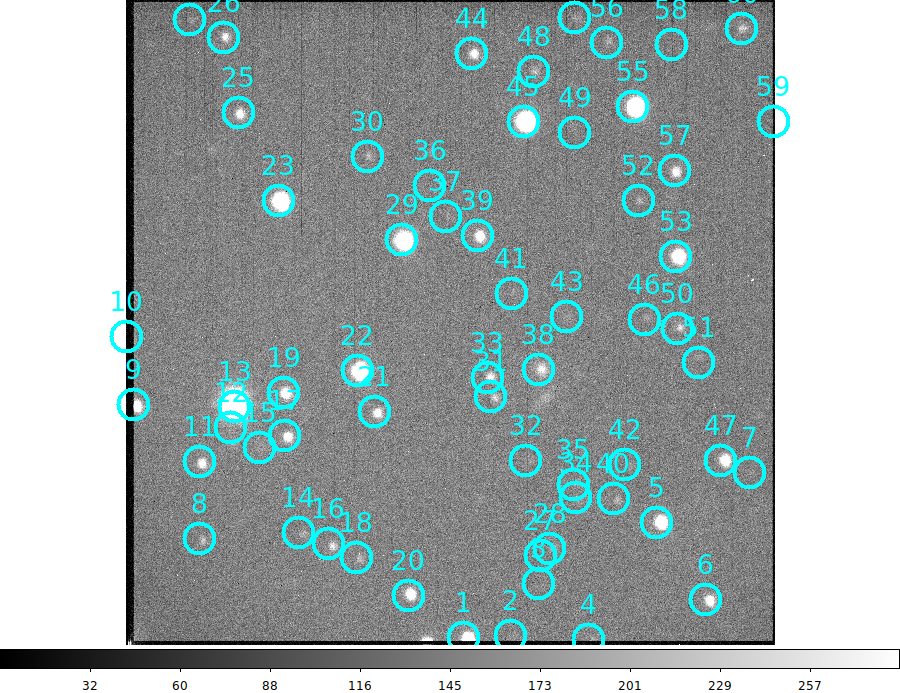Five good nights in Oct2019
Last updated: Dec21,2019
In late Oct2019 we hit a week or so of very clear weather. The seeing was generally
good during this time. I colloected five nights of acm data starting of 20191018 (when the moon
was just befor third quarter) to 20191027 when we were close to new moon and doing a lot of
hetdex observations. I'll keep some stream consciousness botes here about the resuctions of
these nights.
- The five good nights.
- Reduction location and initial reduction script.
- My older wcsf methods
- Overplot USNO sources.
The five good nights.
These nights have some moon, but were extremely clear and mostly good seeing.
performed with a script.
% cat BaseDir
/media/sco/DataDisk1/sco/AD/HET_work/acm_nights
% acm_nights_markII list.dates none N
% cat acm.nights_SUMMARY
Basepath used = /media/sco/DataDisk1/sco/AD/HET_work/acm_nights
Date Ntot Nopen Nbias Ndark Nnone Ntemps NoB Nog Nor Noi Moon_illum
20191018 587 355 20 0 202 587 0 99 23 232 84.100
20191020 1003 323 5 0 665 1003 0 208 3 112 66.400
20191022 722 609 5 0 98 722 0 437 0 172 44.900
20191026 659 541 5 0 103 659 0 384 0 157 6.900
20191027 422 361 5 0 46 422 0 240 0 121 2.100
Return to top of page.
Reduction location and initial reduction script..
The ccd processing, image catalog preparation, and onsky sets derivation can be
performed with a script.
% pwd; ls
/home/sco/ACM_work_Oct2019/red_20191018/S
BaseDir list.dates RunDate*
To run a night (above the S subdirectory):
./S/RunDate 20191018
Note that this script (RunDate), will wipe out all previoyus reductions and start
fresh.
Return to top of page.
My older wcsf methods.
The goal now is to develop an automated wcsf system. In the
onsky_set document, I show how to compile
a list of images (for one sky position) for investigative work.
% onsky_set EX1 1 Y N
I pick JUST one image:
% cat List.FINAL_ISET
/home/sco/ACM_work_Oct2019/red_20191018/local_red/FIXUP/20191018T024545.3_acm_sci.fits
Here are some properties of this image prior to WCS calibration
RADESYS = 'FK5 '
CUNIT1 = 'DEGREES '
CUNIT2 = 'DEGREES '
CTYPE1 = 'RA---TAN'
CRPIX1 = 185 / reference pixel
CRVAL1 = 290.697915
CTYPE2 = 'DEC--TAN'
CRPIX2 = 399 / reference pixel
CRVAL2 = 53.34493
CD1_1 = 6.72660898999311E-05
CD1_2 = 3.37937381118536E-05
CD2_1 = -3.3793738111854E-05
CD2_2 = 6.72660898999311E-05
The fiducal pixle is at CRPIX1,CTYPE2 = 185,399
This position, according to the header and xy2sky is:
% xy2sky /home/sco/ACM_work_Oct2019/red_20191018/local_red/FIXUP/20191018T024545.3_acm_sci.fits 185 399
19:22:47.500 +53:20:41.75 J2000 185.000 399.000
To use my older calibration method:
Usage: wcsf /home/sco/ACM_work_Oct2019/red_20191018/local_red/FIXUP/20191018T024545.3_acm_sci.fits N
arg1 - Name of file with list of FITS images (can be full path)
arg2 - run in debug mode (Y/N)
 |
|
This is the first ds9 view of the test image discussed in the text above. The
acm test image is shown on the left. I have labeled the Ra,Dec of one target
identified as target 11 in the DSS image (on the right). I have also marked
with a thick blacj circle the X,Y location used for the CRPIX1,CRPIX2 position
in the original PAS version of the image. This is the value that must be corrected.
As can be seen in the right panel, the Ra,Dec of target 14 is quite different
from that predicted by the PAS header. The RA wiki reports that the IHMP position on the
acm is X.Y=185.2,396.1. This is not exactly the same as the header CRVAL1,CRVAL2=185.399,
but it is close. Hence, the WCS error that PAS makes is in the assignment of Ra,DEc
(CRVAL1,CRVAL2) for this position. Re-deriving a correct value for CRVAL1,CRVAL2 is
our current goal.
|
 |
|
This is the second ds9 view of the test image discussed in the text above.
After we have identified a target in the field (previous figure) we can simply use
the X,Y (for CRPX1,CRPIX2) and the Ra,Dec (for CRVAL1,CRVAL2) of that position to
fix up the PAS acm image header. This is performed by the rough_wcs routine and it
gives us what we see above. We have simply collected an astrometric catalog from the
USNOB-1.0 catalog, and overplotted those sources on the corrected image. Now, instaed
of all the source being displaced by 20-30 arcseconds, most of the circles fall on
top of a real source in our acm image. Those circles that are emtpy are probably
associated with sources that were too faint for our acm image (or were just incorrect
entries in the USNO catalog). In any case, we now have an image that is calirbated to
better than 1 arcsecond of error, and henne were are able to cross-match to other
astrometric catalogs and derive n improved WCS solution using many more stars.
|
At the end of a successful wcsf run the WCS-calibrated
version of our image will reside in the WCS subdiretory of the local reduction directory. In
addition to a valid WCS header, the image will cnatin useful header cards pertaining to
the new astrometric solution:
% ls ./local_red/WCS
20191018T024545.3_acm_sci.fits
# Here are some of the the header cards in our new image
CTYPE1 = 'RA---TAN' / Gnomonic Projection
CTYPE2 = 'DEC--TAN' / Gnomonic Projection
CRPIX1 = 387.000 / Axis 1 Reference
CRPIX2 = 385.000 / Axis 2 Reference
CRVAL1 = 290.722656250 / Ra at Frame, J2000 (deg)
CRVAL2 = 53.324096680 / Dec at Frame, J2000 (deg)
CROTA2 = 333.147003173828 / Image Twist +AXIS2 W of N, (deg)
CDELT1 = 0.0000752099586 / Axis 1 Pixel Size (degs)
CDELT2 = 0.0000752099586 / Axis 2 Pixel Size (degs)
RMSRA = 0.1360 / RA_rms in arcsec
RMSDEC = 0.1810 / DEC_rms in arcsec
NUMWCS = 19 / Number of points in WCS fit
AZHET = 321.2751 / HET structure AZ (deg)
HETQ = 295.6245 / HET parallactic angle (deg)
POSANG = 26.8530 / 360-CROTA2 (tzcal.sh,old)
TZ = 91.2290 / PA-HETQ (tzcal.sh,old)
The POSANG and TZ parameters are non-standard cards giving positional angle
information that was used to adjust older versions of shuffle following an
FPA take-down.
Return to top of page.
Overplot USNO sources.
The WDS derivation in the previous section was succesful. In preparation for
deriving an autometed version of this prcedure, I want to be able to overplot
USNO targets on my calibrated image using the curcle markers that are
scaled in size to reflect magnitude (bright sources large, faint sources small).
I have to build this into the cdfp2reg.shroutine, and I discuss this in
a document about overplotting USNO sources
with ds9. Basically, the goal is to have a display like that belwo give me
overplotted points that convey magnitude as well as position.
% usno_look_wcs_run /home/sco/ACM_work_Oct2019/red_20191018/Test1/local_red/WCS/20191018T024545.3_acm_sci.fits N
This seems like a lot of extra trouble, but I think it will make visually testing
my auto-match algorithm much easier.
Return to top of page.
Back to SCO code page

